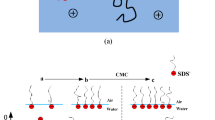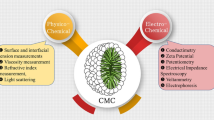Abstract
Characterizing the phase behavior of surfactants in solution is essential to their application on different industrial and research fields. Nowadays, the methodology to determine surfactant structural changes in solutions relies on measurements of bulk-solution properties, which frequently fail when working at highly low surfactant solution. Therefore, alternative strategies are required to accomplish such evaluations. Here, we demonstrate that electrochemical impedance spectroscopy (EIS) can be easily applied to characterize surfactant-phase behavior by monitoring structural modifications at the surfactant solution-electrode interface. A graphical analysis of EIS measurements in form of Bode-type diagrams allows obtaining two representative electrochemical parameters: the surfactant solution resistance and the characteristic time constant associated with the electrochemical double-layer formation, as a function of both temperature and surfactant concentration. These parameters are found to be correlated with the change on the surfactant phase and therefore, its detection is accurately performed even at low surfactant concentrations.
Graphical abstract








Similar content being viewed by others
References
Ohlendorf D, Interthal W, Hoffmann H (1986) Surfactant systems for drag reduction: physico-chemical properties and rheological behaviour. Rheol Acta 25:468–486. doi:10.1007/BF01774397
Shikata T, Hirata H, Kotaka T (1988) Micelle formation of detergent molecules in aqueous media. 2. Role of free salicylate ions on viscoelastic properties of aqueous cetyltrimethylammonium bromide-sodium salicylate solutions. Langmuir 4:354–359. doi:10.1021/la00080a019
Rehage H, Hoffmann H (1988) Rheological properties of viscoelastic surfactant systems. J Phys Chem 92:4712–4719. doi:10.1021/j100327a031
Wunderlich I, Hoffmann H, Rehage H (1987) Flow birefringence and rheological measurements on shear induced micellar structures. Rheol Acta 26:532–542. doi:10.1007/BF01333737
Strivens TA (1989) The rheological properties of concentrated cetyltrimethylammonium bromide-salicylic acid solutions in water. Colloid Polym Sci 267:269–280. doi:10.1007/BF01410585
Göbel S, Hiltrop K (1991) Influence of organic counterions on the structure of lyotropic mesophases. In: Corti M, Mallamace F (eds) Trends colloid interface sci. V. Steinkopff, Darmstadt, pp 241–242
Soltero JFA, Bautista F, Puig JE, Manero O (1999) Rheology of cetyltrimethylammonium p-toluenesulfonate-water system. 3. Nonlinear viscoelasticity. Langmuir 15:1604–1612. doi:10.1021/la971299a
Ozeki S, Ikeda S (1984) The sphere-rod transition of micelles of dodecyldimethylammonium bromide in aqueous NaBr solutions, and the effects of counterion binding on the micelle size, shape and structure. Colloid Polym Sci 262:409–417. doi:10.1007/BF01410261
Soltero JFA, Puig JE, Manero O, Schulz PC (1995) Rheology of cetyltrimethylammonium tosylate-water system. 1. Relation to phase-behavior. Langmuir 11:3337–3346. doi:10.1021/la00009a013
Soltero JFA, Puig JE, Manero O (1996) Rheology of the cetyltrimethylammonium tosilate-water system. 2. Linear viscoelastic regime. Langmuir 7463:2654–2662. doi:10.1021/la950368n
Sepúlveda L, Gamboa C (1987) Effect of temperature on the viscosity of cationic micellar solutions in the presence of added salts. J Colloid Interface Sci 118:87–90. doi:10.1016/0021-9797(87)90437-1
Gamboa C, Rios H, Sepulveda L (1989) Effect of the nature of counterions on the sphere-to-rod transition in cetyltrimethylammonium micelles. J Phys Chem 93:5540–5543. doi:10.1021/j100351a043
Bravo-Anaya LM, Macias ER, Ramos FC et al (2013) DNA transitions by an adsorption impedance study. J Electrochem Soc 160:G69–G74. doi:10.1149/2.029306jes
Bravo-Anaya LM, Larios-Durán ER, Casillas N et al (2013) Characterization of DNA/buffer/H2O system through electrochemical impedance spectroscopy (EIS). ECS Trans 47:109–121. doi:10.1149/04701.0109ecst
Pajkossy T, Kolb DM (2007) Double layer capacitance of the platinum group metals in the double layer region. Electrochem Commun 9:1171–1174
Bard AJ, Faulkner LR (2001) Electrochemical methods : fundamentals and applications. Anti-Corros Methods Mater. doi:10.1016/j.aca.2010.06.020
Kauffman GB (2009) Electrochemical impedance spectroscopy. By Mark E. Orazem and Bernard Tribollet. Angew Chem Int Ed 48:1532–1533. doi:10.1002/anie.200805564
Scully John R, Silverman David C (1993) Electrochemical impedance: analysis and interpretation. ASTM. doi:10.1520/STP1188-EB
Bockris JO, Reddy AKN (2015) Modern electrochemistry: an introduction to an interdisciplinary area. Statew Agric L Use Baseline. doi:10.1017/CBO9781107415324.004
Alexander CL, Tribollet B, Orazem ME (2016) Contribution of surface distributions to constant-phase-element (CPE) behavior: 2. Capacitance. Electrochim Acta 188:566–573
Hirschorn B, Orazem ME, Tribollet B et al (2010) Constant-phase-element behavior caused by resistivity distributions in films: I. Theory. J Electrochem Soc 157:C452–C457
Gravsholt S (1976) Viscoelasticity in highly dilute aqueous solutions of pure cationic detergents. J Colloid Interface Sci 57:575–577. doi:10.1016/0021-9797(76)90236-8
Nemoto N, Kuwahara M (1994) Self diffusion and viscoelasticity of elongated micelles from cetyltrimethyl-ammonium bromide in aqueous sodium salicylate solution. II. Temperature effect. Colloid Polym Sci 272:846–854. doi:10.1007/BF00652426
Narayanan J, Manohar C, Langevin D, Urbach W (1997) Growth of cetyltrimethylammonium tosylate micellesA frapp study. Langmuir 13:398–401. doi:10.1021/la9607262
Macías ER, Bautista F, Soltero JFA et al. (2003) On the shear thickening flow of dilute CTAT worm-like micellar solutions. J Rheol 47:643. doi: 10.1122/1.1562479
Bautista F, Fernández VVA, Macías ER et al (2012) Experimental evidence of the critical phenomenon and shear banding flow in polymer-like micellar solutions. J Nonnewton Fluid Mech 177–178:89–96. doi:10.1016/j.jnnfm.2012.03.006
Acknowledgements
J. F. A. Soltero and E. R. Larios-Durán acknowledge to CONACYT for financial support through Projects Nos. 223549 and 253873, respectively. J. Jesús Gómez-Guzmán acknowledges the doctoral scholarship granted by CONACYT.
Author information
Authors and Affiliations
Corresponding author
Rights and permissions
About this article
Cite this article
Gómez-Guzmán, J.J., Macías, E.R., Soltero, J.F.A. et al. Application of electrochemical impedance spectroscopy as a technique to characterize phase diagrams of surfactant solutions. J Appl Electrochem 47, 1273–1282 (2017). https://doi.org/10.1007/s10800-017-1115-9
Received:
Accepted:
Published:
Issue Date:
DOI: https://doi.org/10.1007/s10800-017-1115-9




